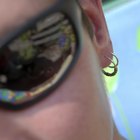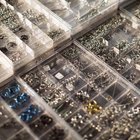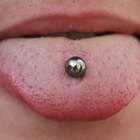
moodboard/moodboard/Getty Images
Common areas for nose piercings are the nostrils, the septum and the bridge. Healing times vary for each location. Nostril piercings heal in two to four months, bridge piercings heal between eight and 10 weeks, while septum piercings may take between six and eight months to heal. Problems associated with nasal piercings may also be specific to each location,or common with all three.
Infection
As with other body piercings, nose piercings have a risk of infection. According to the American Academy of Family Physicians (AAFP), infection from nasal piercing demands aggressive treatments with antibiotics to fight the Staphylococcus species commonly found in the nasal mucosa. Infections are common during the piercing healing process, but they can also occur after the piercing has healed completely.
Jewelry Swallowing, Aspiration, Migration
Jewelry housed in nasal piercings can be swallowed or aspirated through the nasal cavity. Nose piercing jewelry may also migrate forward from its original location. Jewelry swallowing and aspiration can occur with nostril and septum piercings. Another problem associated with nasal jewelry is that it can be pulled out, causing the jewelry back to become embedded in the wall of your nose. Surgical removal can be necessary if the back becomes embedded.
Necrosis of Nasal Wall
One of the most serious problems associated with nose piercings is necrosis of the nasal wall. Necrosis means the localized death of living cells. Nose piercings through the septum and both lateral walls are potentially at risk for necrosis.
Perichondritis of Nasal Wall
Nose piercings through the cartilage run the risk of perichondritis of the nasal wall. Perichondritis is the inflammation of the perichondrium, a dense membrane of connective tissue that wraps around most cartilage in the human body.
Formation of Septal Hematoma
Piercing the septum of your nose can cause septal hematoma, which is bleeding or bruising within the septum. The septum is the area of skin and cartilage that separates your two nostrils. Symptoms of septal hematoma include nasal congestion, difficulty breathing and painful swelling.
Rejection
Rejection is a possibility in any type of body piercing, but bridge nose piercings have a high rate of rejection. It occurs when your body literally pushes the metal jewelry out of the pierced area. Rejections may occur during or after the healing time for nose and other body piercings, and may be related to the type of metal your jewelry is made from.
Related Articles

Harmful Effects of Wearing Magnetic ...

Facts on Nose Piercings

Places to Pierce Your Ear

How to Take Out a Lip Ring Stud

Why Do People Pierce Their Ears?

How to Care for a Rook Piercing

Complications of Nipple Piercing

What Is Bio-Flex Made of for Piercings?

Swollen Lymph Nodes in Horses

Reactions to Nose Piercings

How to Stretch Ears With Tape

How to Get Rid of Dark Spots Around a ...

How Dangerous Is It to Pierce Your ...

List of Body Parts That Can Be Pierced

Health Risks of Marble Dust

How to Measure Your Earring Gauge Size

What Are the Dangers of Men's Brazilian ...

Can I Mix Vitamin C and Copper Peptides?

How to Remove a Labret Piercing

Copper Peptides Side Effects
References
Writer Bio
Katherine Kally is a freelance writer specializing in eco-friendly home-improvement projects, practical craft ideas and cost-effective decorating solutions. Kally's work has been featured on sites across the Web. She holds a Bachelor of Science in psychology from the University of South Carolina and is a member of the Society of Professional Journalists.
Photo Credits
moodboard/moodboard/Getty Images